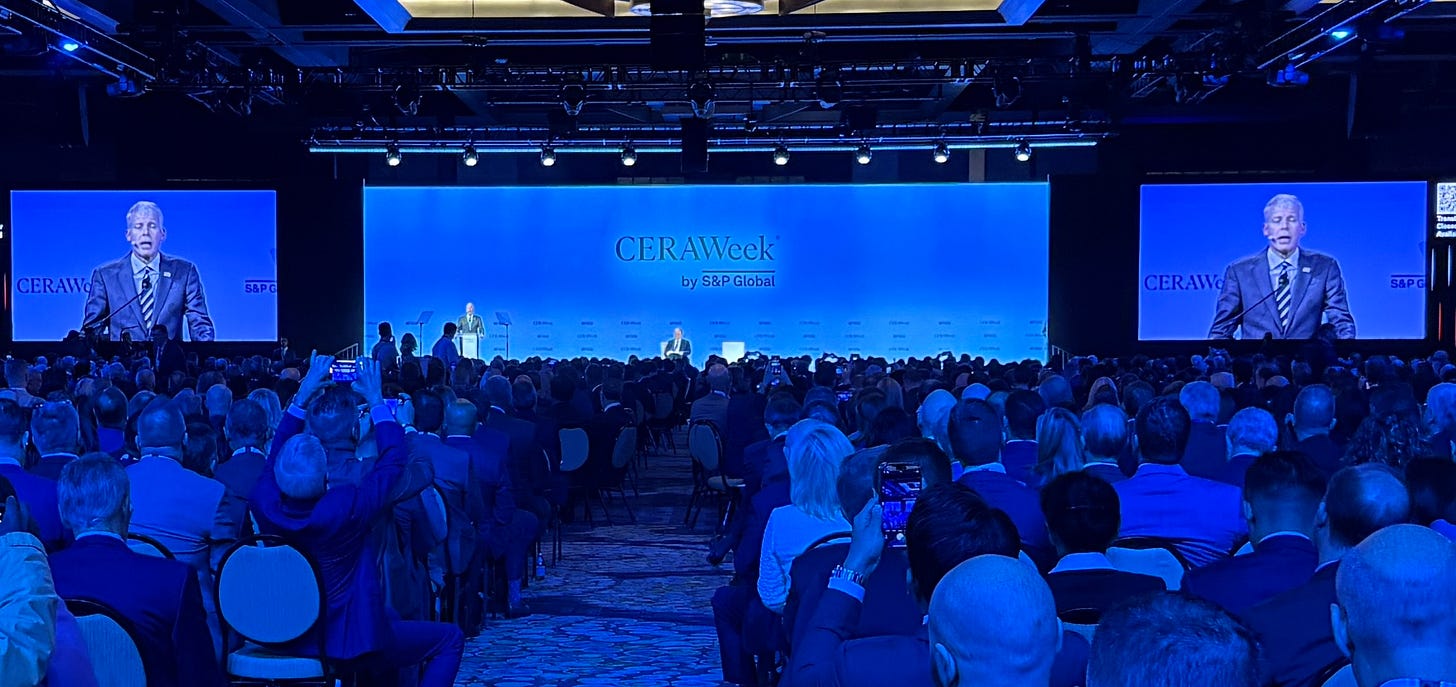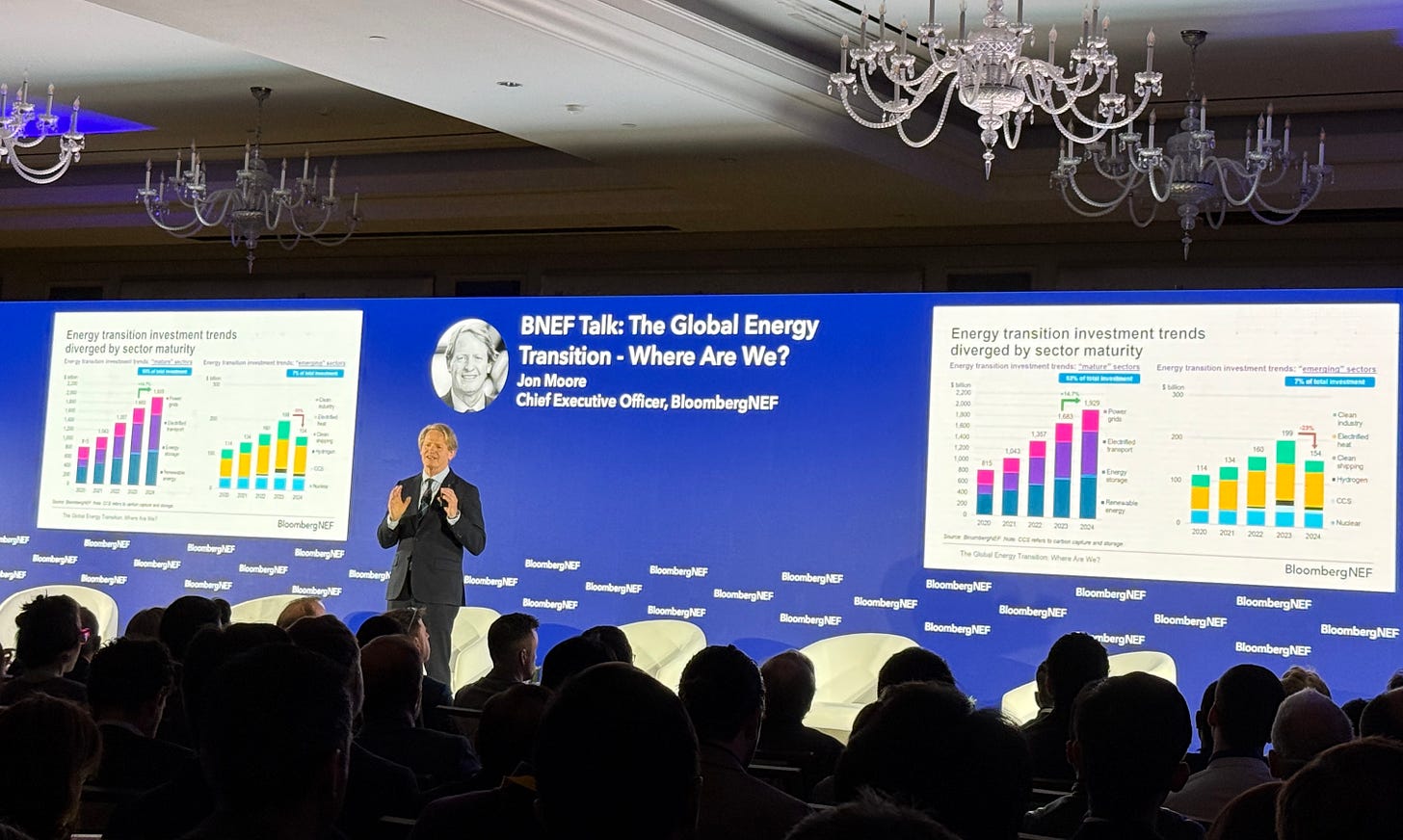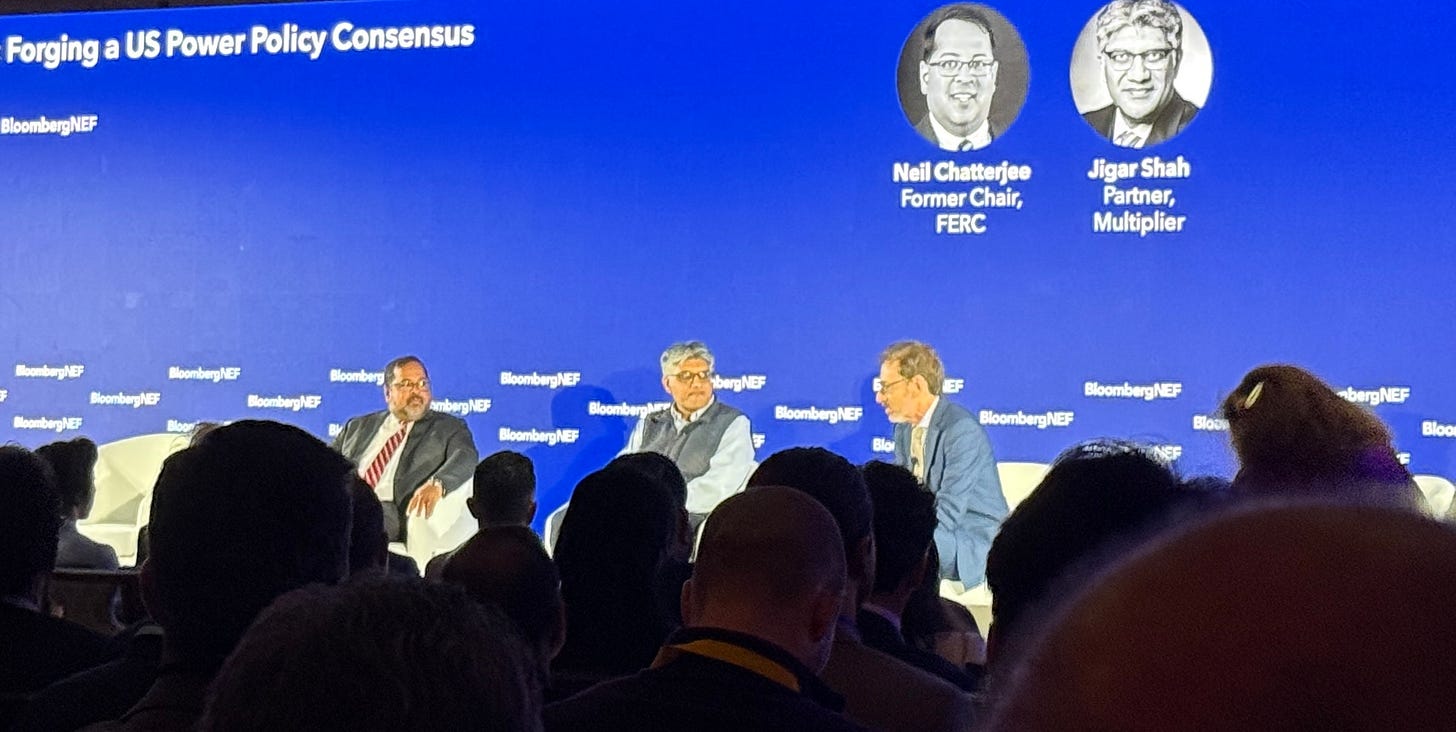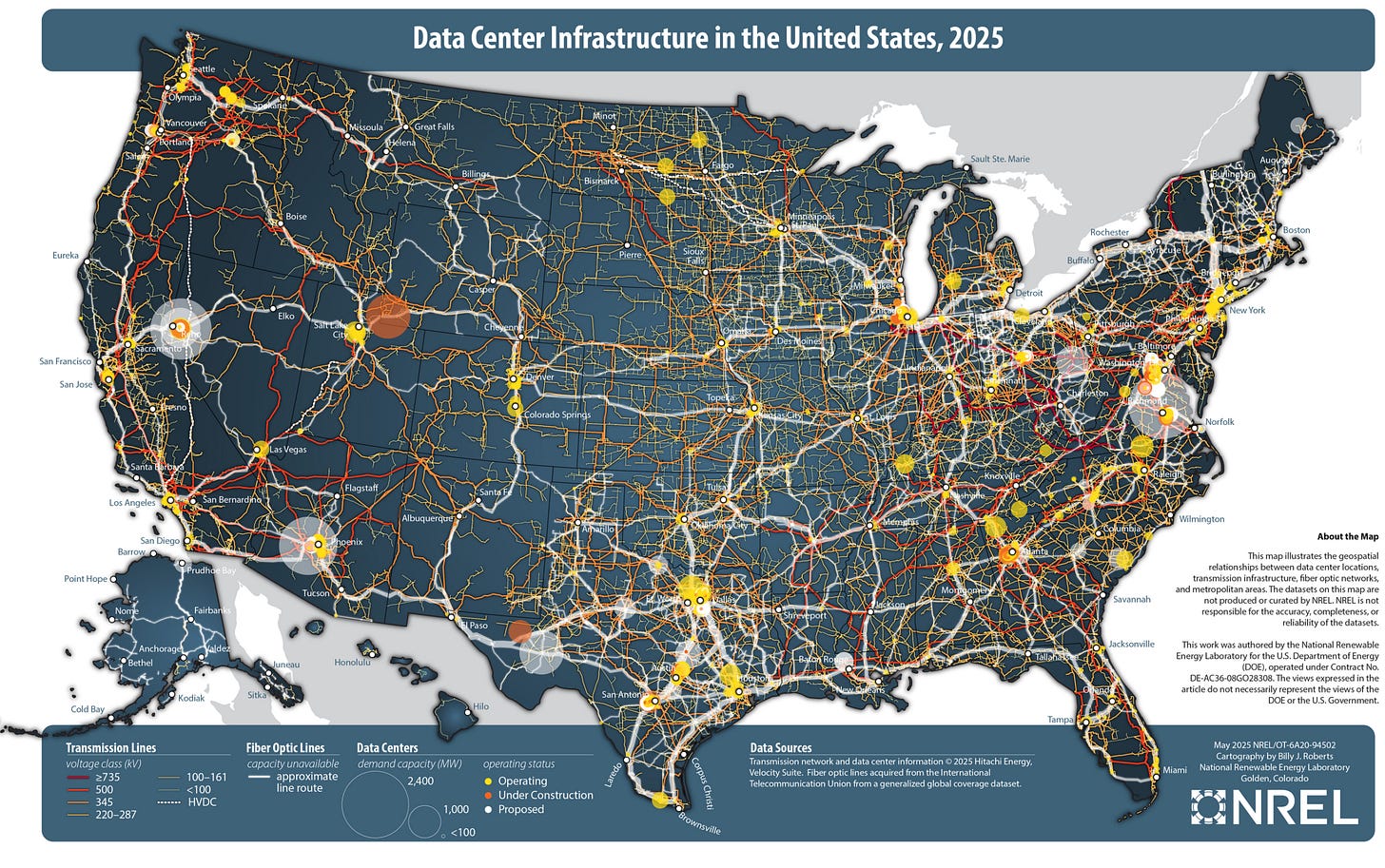Ok, here goes with the cliche: This is a tale of two conferences.
The first, in March, was a fossil fuel fan gathering I attended in the Texas oil patch. Last week, it was a clean energy confab in New York City.
What’s interesting and unusual is the two conferences seemed engaged in one dialogue. To me at least, the two sides of the energy world seemed less squared off in implacable opposition, more groping towards a practical approach to overhauling an energy system everyone agrees is in need of an overhaul.
While a good thing, this squishy new common ground grows from some harsh realities for both sides.
🛢️The current fossil fuel dominated energy system won’t cut it going forward. It’s too dirty, depends too much on free trade and fuels susceptible to price swings. It’s too extractive and too focused on finding ever more supply — even if those fossil fuels are not going away any time soon. All one has to do to understand this is look at the rapidly compounding cost of climate change in the form of hurricane and fire damage last year in the United States.
☀️The emerging new energy system — where electricity will be king and clean sources one day rule — needs a lot more work and investment. Clean energy is ready for prime time. But this decades-long production won’t easily be rolled out in haste — as urgent as the task may be. Exhibit A is Spain’s power travails over the past week.
For the climate, all this amounts to good news and bad. On the good side, solutions are no longer just over the horizon, they’re here and now. They’re helping us edge back from the worst potential climate fallout. More important, they’re helping prepare us to accelerate progress.
Yet we’re not going to avoid some very troublesome climate impacts. In the U.S., we’re going backwards in terms of government policy. Even Europe is backsliding. The upshot: the new energy ecosystem, like all ecosystems, will have to deal with the fallout from a worsening climate in order to survive and help solve it.
Now this nascent, halting dialogue will play out against the backdrop of the Trump administration’s confounding and uncertainty sowing trade, security and energy policies.
The first conference was CERAWeek, an oil and gas jamboree if there ever was one. Fossil fuel triumphalism was on full florid display. The Trump administration’s interior and energy secretaries headlined the event, trumpeting the return of hydrocarbons to center stage. They trashed renewables.
And yet…acknowledgement of some new realities was everywhere below the surface. I wrote a story about this for Cipher News, which you can read here.
The most prominent sign was the crowd around CERAWeek’s founder and father figure — the author and analyst who literally wrote the book on the oil industry, Daniel Yergin. He was talking about what for many at CERAWeek is a worrisome trend away from fossil fuels to renewable energy.
Not a “energy transition” at all, Yergin assured them. It’s an energy “addition.” Fossil fuels won’t be phased out, but built upon. As energy demand grows, new sources will layer upon old ones, which will keep growing. Look at coal, long overshadowed by oil but still growing, he and his two fellow authors told them, reprising their much-discussed essay in Foreign Affairs magazine.
Yet discussions at CERAWeek revolved around how fossil fuels, especially natural gas, would become cleaner, more efficient, and even take a back seat to renewables.
The head of the largest U.S. utility, CEO of NextEra Energy John Ketchum, delivered a wake up call: natural gas would meet only a small slice of the fast-growing demand for energy. As has been the case for years now, virtually all of the new electricity demand will be served by renewable sources. They’re cheaper and faster to build.
Then last week I dropped in on the BloombergNEF conference in NYC. There the surface vibe was subdued — for same reasons CERAWeek was outwardly jubilant.
And yet…below the surface was a quiet confidence that it’s not just the future that belongs to clean, renewable energy. So does the present. Ketchum wasn’t there, but squared the circle from his CERAWeek interview in the company’s earnings call:
“We should be thinking about renewables and battery storage as a critical bridge to when other technology is ready to scale, like new gas-fired plants,” he said.
The BNEF panelists I heard pushed for a true “all of the above” solution, one that sees renewables partnering with natural gas for power production peaks when there’s little sun or wind and batteries can’t yet fill in.
“We can actually accelerate…now with solar, storage and gas peakers,” Jigar Shah, a solar tycoon who headed a key clean energy department in the Biden Administration, told the conference.
A nationwide power outage in Spain the day before the BNEF conference focused minds. A darling of the clean energy world, Spain has pushed renewables to more than two-thirds of power generation overall, with many hours of the day powered entirely by solar.
The exact cause of the disastrous outage has yet to be determined. But it’s obvious something about this dynamic new energy system needs to be addressed. The fault almost certainly won’t lie with renewable energy per se, any more than the gas generators and pipelines that failed during a massive winter storm in Texas several years ago were directly to blame for a statewide power outage that year.
The problem in Texas wasn’t gas per se, but the fact that gas turbines and pipelines weren’t insulated to work at temperatures this low for that long. Spain’s grid seems likely to need some shoring up with batteries and other means of quick response to prevent future blackouts.
In any case, its travails provided an object lesson in the danger that quiet confidence veers towards hubris.
Whether all this amounts to an energy “transition” or an energy “addition” — we’ll find out eventually — something has changed the discussion.
And that something is artificial intelligence. The economic and security imperatives of AI have thrust the U.S. into the same desperate race to meet fast-rising energy demand that the developing world has been in for decades now.
Beneath the fossil fuel triumphalism of CERAWeek in Texas and the climate concern in New York, both sides have accepted these realities as new and exciting challenges.
Neil Chatterjee, a former high-ranking energy official appointed by Trump in his first administration, attended both CERAWeek and BNEF.
On a panel in New York, he compared California and Texas, the top two states in the U.S. for renewable power.
“Maintaining both affordability and reliability will be the energy challenge of the next couple of years. You layer on top of that the challenges of extreme weather events and climate change, it’s going to test grid operators, regulators, policy makers, industry and the like,” he told the BNEF audience.
”We’ve seen in the last four or five years both Texas, a conservative state, and California, a progressive one, both have their grids pushed to the brink for different reasons. California because of heat and wildfires. Texas because of a cold weather event. What it shows you is that the power grid doesn’t care what your politics are. Climate change doesn’t care what your market design is. We’ve got to come together and address this.”








Every time I read Bill Spindle's essays I learn not one thing, but many! This time I learned and better understand the opposing camps in this ongoing struggle to save our planet. I admire the people who so desperately support the war of our planet. In fossil fuel I feel conflicted because of all the families that will lose their income as workers. If I lived in West VA. (as an example) I would be continually anxiious about our state's economy
Powerful stuff!